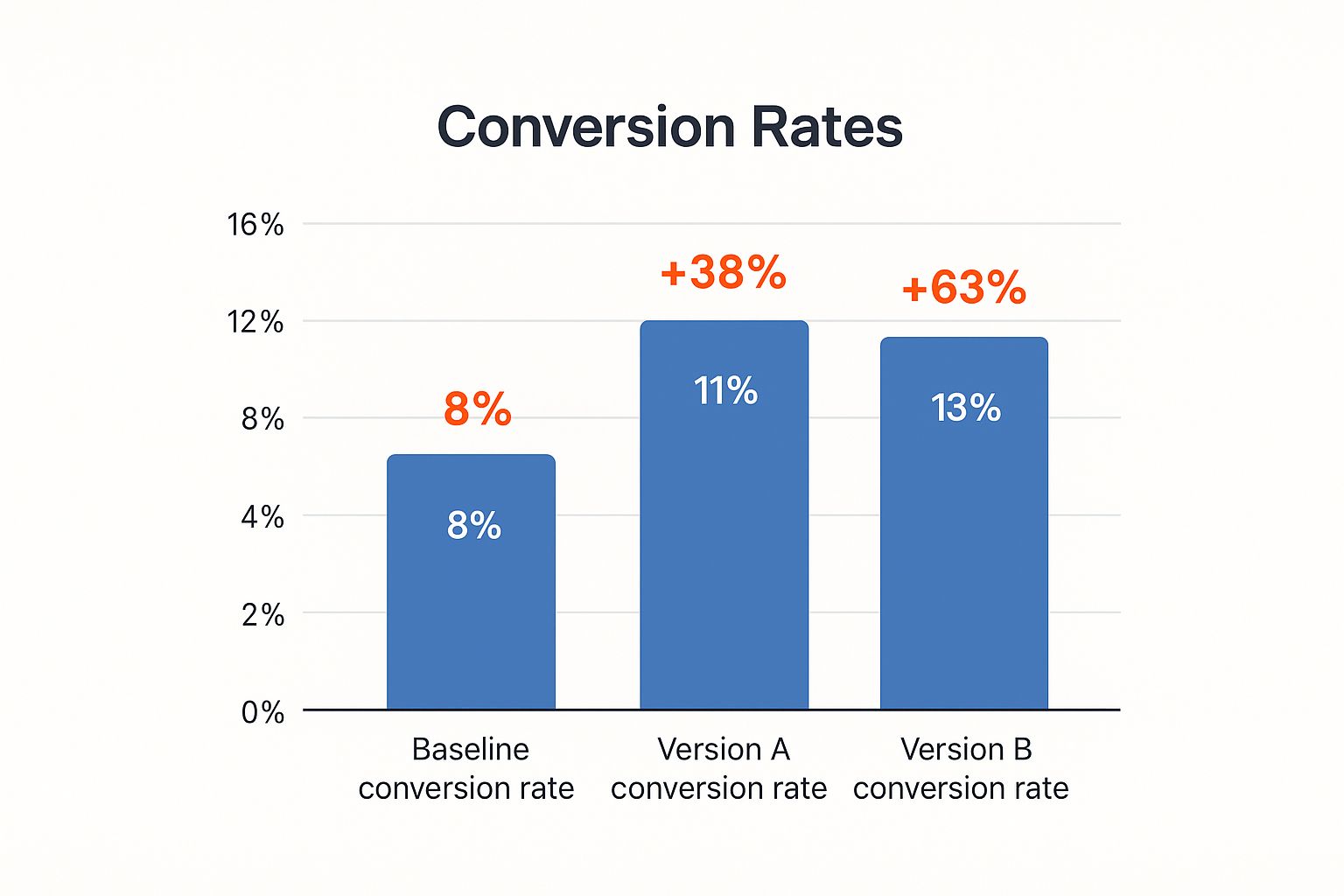The very first thing you need to do when trying to find your target audience is to let go of a dangerous idea: that your product is for everyone. It's a tempting thought, but it's also a trap. The real secret is to zero in on a small, specific group of people whose problems you are uniquely equipped to solve. This is how you build something they genuinely need and create marketing that actually speaks to them.
Why 'Everyone' Is The Wrong Target Audience
So many early-stage founders and indie hackers fall into this trap. They believe their idea has universal appeal, and while that ambition is admirable, it's a fast track to burning through cash with a message that's too generic to connect with anyone.
When you try to talk to everybody, you end up talking to nobody. Think about it: would you rather have someone shout your name in a packed stadium or walk right up to you for a direct conversation? The first is just noise; the second is personal and impossible to ignore. That’s the difference between targeting a broad market and a well-defined niche.
The Steep Cost of Ambiguity
Casting a wide net sounds like a good strategy, but it just means your efforts are spread too thin. Your marketing budget evaporates as you try to reach disconnected groups with different needs, and your product roadmap gets cluttered with features that don't truly excite any single user.
The question isn't, "Who could buy this?" It's, "Who desperately needs this right now?"
Making this strategic shift from broad to niche is the most critical first step. The sheer size of the online world can be deceiving. Sure, there are 5.56 billion people online, but how they connect and what they do varies wildly. For instance, internet penetration in Northern Europe is almost 99%, but it drops to just 27% in low-income countries. Digging into global digital trends helps you understand these nuances and where your specific audience actually lives and breathes online.
The fastest way to build something nobody wants is to build something for everyone. True product-market fit is born from solving a specific pain for a specific group of people.
Let's look at what this difference in focus really means in practice.
Broad vs Niche Audience Targeting Outcomes
| Characteristic | Broad Audience Approach | Niche Audience Approach |
|---|---|---|
| Messaging | Generic, trying to appeal to all. | Highly specific, using insider language and addressing precise pain points. |
| Marketing Spend | High cost, low ROI. Spread thin across multiple channels. | Lower cost, high ROI. Focused on channels where the niche is active. |
| Product-Market Fit | Difficult to achieve; feedback is conflicting and vague. | Easier to achieve; feedback is clear, actionable, and consistent. |
| Competition | Competing with everyone, including large, established players. | Fewer direct competitors; easier to become the go-to solution. |
| Customer Loyalty | Low. Customers have no strong connection to the brand. | High. Customers feel understood and become loyal brand advocates. |
As you can see, the niche approach isn't about limiting your potential; it's about focusing your power to build a strong, defensible foundation for growth.
Your Ideal Customer Profile as a North Star
To escape the "everyone" trap for good, you need a compass. That compass is your Ideal Customer Profile (ICP). An ICP is a sharp, detailed description of the perfect customer for your business. This isn't just a list of demographics—it's a strategic document that outlines the exact person or company that gets the most out of your solution while also providing the most value back to you.
Think of your ICP as your North Star. It guides every single decision you make, from which features to build next to the exact words you use in your email outreach. By crafting a detailed ICP, you turn the fuzzy concept of "the market" into a real, tangible person you can focus on helping. That focus is what builds a loyal customer base that will stick with you for the long haul.
Finding Real User Problems in Online Communities
If you think your best product ideas will come from a sterile boardroom, you're looking in the wrong place. The real gold is found in the wild—in the raw, unfiltered conversations happening right now in online communities. This is where people get brutally honest about their frustrations, cobble together clunky workarounds, and openly wish for a better solution. To truly understand your target audience, you have to learn to listen where they live.
For indie hackers and solopreneurs, this means diving into places like Quora, niche forums, and especially Reddit. These platforms are overflowing with people describing their exact needs. The problem? It's a firehose of information. Trying to manually sift through thousands of posts and comments is a surefire way to burn out before you even get started.
The Power of Listening to Unfiltered Conversations
When you're scrolling through a subreddit like r/SaaS or r/smallbusiness, you’re getting a direct feed from the minds of your potential customers. You see the exact words they use, the context behind their struggles, and the hacks they've already tried. That’s a depth of qualitative insight a survey could never touch.
This is how you stop guessing what people want and start knowing what they need. Keep an eye out for a few key signals:
- Expressions of frustration: Look for the classic tells—posts starting with "How do I…", "I'm so sick of dealing with…", or "Is anyone else struggling with…?"
- DIY solutions: Pay close attention when people describe their elaborate setups involving spreadsheets, Zapier, and a handful of other apps duct-taped together. That's a huge sign of a gap in the market.
- "I wish there was a tool that…" posts: These are pure gold. The market is literally handing you a product brief on a silver platter.
Automating Problem Discovery with ProblemSifter
While manually trawling Reddit is incredibly insightful, it’s not scalable. A much smarter way to work is to automate the discovery process. This is precisely where a tool like ProblemSifter becomes an indie hacker's secret weapon. It was built to do one thing exceptionally well: scan specific subreddits and pull out real, unfiltered problems people are discussing.
Instead of spending hundreds of hours on manual research, you get a curated feed of startup ideas sourced directly from actual user discussions.

As you can see, ProblemSifter lays out the problems clearly, making it easy to spot opportunities that align with your skills. Its real power is in turning chaotic, unstructured community chatter into a clean, actionable list of potential business ideas.
But what really makes it different is how it closes the loop between idea and audience.
Unlike other tools, ProblemSifter doesn’t just suggest ideas—it connects you to the exact Reddit users asking for them.
This creates an immediate, direct line to people experiencing the pain point. You don't just get the "what," you get the "who" and the "where"—the original post and the usernames of people who have already raised their hands. This is invaluable for both ideating your solution and promoting it with targeted outreach. You can learn more about this approach in our guide on how to find the problem before building the solution.
A Practical and Affordable Path to Validation
Let’s be real: for indie hackers and solopreneurs, every dollar counts. Many market research tools come with eye-watering monthly subscriptions that just don't make sense for a solo founder. ProblemSifter takes a different route, one that aligns with the builder's mindset.
The pricing is straightforward, with no subscriptions or hidden fees. For just $49, you can get lifetime access to a curated list of real startup problems from one subreddit. If you want to cast a wider net, it's $99 for lifetime access to three subreddits.
Think about that. A one-time payment gives you a constantly updating stream of insights and a direct link to your first potential customers. It’s a low-cost, high-impact way to find and validate your audience before you ever write a line of code or design a landing page. This is how you move from just finding problems to making genuine customer connections, efficiently.
Alright, you've done the groundwork. You've waded through Reddit threads and online forums, and your notepad is brimming with the raw, unfiltered problems people are actually facing. You've officially moved past guessing what your customers want and into knowing.
Now it’s time to shape that messy, scattered data into a clear, actionable portrait of your ideal customer. This is where you construct your Ideal Customer Profile (ICP)—the strategic document that will become your north star, guiding every single decision you make from here on out.

Think of your ICP as the architectural blueprint for your perfect customer. It’s not just a list of demographics. It’s a rich synthesis of problems, ambitions, and behaviors that define the person or company who will get the most profound value from your solution—and, in return, provide the most value back to you.
ICP vs. Buyer Persona: What’s the Real Difference?
Before we go any further, let's clear up a common point of confusion. People often use "ICP" and "Buyer Persona" interchangeably, but they serve distinct, complementary roles.
- Ideal Customer Profile (ICP): This is your 30,000-foot view. It describes the target company or organization you should be selling to. It’s a staple in B2B, but you can adapt it for B2C by focusing on household-level characteristics. The core question it answers is: "What type of company is a perfect fit for us?"
- Buyer Persona: This zooms in on the ground level. It focuses on the actual people inside those ideal companies—the ones you need to talk to and convince. A persona is a semi-fictional character based on your research that represents a specific user type. It answers: "Who is the person we're trying to help?"
As a solopreneur or indie hacker, you’ll probably start by building a persona, since your first customers are almost always individuals. But eventually, having both gives you a powerful one-two punch for smart, sustainable growth.
Turning Raw Problems into a Working Profile
The research you’ve gathered from places like Reddit, industry forums, or a discovery tool like ProblemSifter is your raw material. The next step is to organize it into a structured, usable profile. Just open a fresh document and start building it out with these key components.
Demographics: The "Who"
This is the foundational, quantifiable information. The key is not to guess. Instead, look for clues in the user bios, post histories, and community discussions you've been analyzing.
- Age Range: What's the general age of the people most vocal about this problem?
- Location: Are they clustered in specific countries, states, or even cities?
- Job Title/Industry: What roles do they have? Get specific. For example, "Marketing Manager at a B2B SaaS startup with 50-100 employees."
- Company Size/Revenue (for B2B): Are you dealing with scrappy solopreneurs or managers in 500-person companies?
Psychographics: The "Why"
This is where you get inside their heads. Honestly, this is the most critical part of understanding your audience because it uncovers the deep-seated motivations that drive their decisions.
- Goals & Aspirations: What are they ultimately trying to achieve in their job or life? Think bigger than just their immediate task. (e.g., "Secure a promotion by Q4," or "Automate tedious tasks to free up at least 5 hours a week for creative strategy.")
- Frustrations & Pain Points: This is your goldmine. List the exact, word-for-word problems you found in your research. (e.g., "I waste 10 hours a week manually pulling and compiling reports," or "I struggle to find validated startup ideas that aren't just copies of something else.")
- Values & Beliefs: What do they fundamentally care about? (e.g., "Values efficiency and clever workarounds over big-budget tools," or "Believes in supporting and using open-source software whenever possible.")
Treat your first ICP as a living document, not a stone tablet. It’s a hypothesis meant to be tested and refined. With every customer conversation and new insight, you'll sharpen its focus, making it an increasingly powerful guide for your business.
Putting It All Together: A Practical Example
Let’s say you used ProblemSifter to analyze the r/solopreneur subreddit and found a recurring, painful theme around managing project finances. From that data, you could draft an initial buyer persona. Let's call her "Alex the Freelance Developer."
Here’s what that might look like:
- Role: Freelance Web Developer
- Age: 28-35
- Pain Points: Spends way too much time creating and chasing invoices. Constantly struggles to track project-level profitability. Worries about unpredictable cash flow from month to month.
- Goals: Wants to spend more time coding and less on administrative busywork. Needs a simple financial dashboard that isn't as bloated and complex as enterprise accounting software.
- Watering Holes: Actively participates in
r/solopreneurand Indie Hackers. Follows specific tech influencers on Twitter for advice and industry news.
Even this simple profile is incredibly powerful. It gives you a clear signal on what features to build, what language to use in your marketing, and exactly where to go to find your first users. Creating this profile is a foundational step in truly identifying customer needs, effectively turning a mountain of broad market research into a focused, actionable plan.
Matching Your Audience to the Right Platforms
Your audience isn't out there waiting for you to build a new digital town square; they already have their favorite spots to hang out online. The real work is figuring out where they are and showing up. Once you've got a solid Ideal Customer Profile (ICP) roughed out, the next move is to map those customer traits to the platforms they're already scrolling through every day.
Trying to be everywhere at once is a surefire way to burn out, especially if you're a solopreneur or a small team. You have to be strategic. Pick one or two platforms where your ideal customers are most concentrated and, more importantly, engaged. This isn't just about shouting your marketing message into the void; it's about efficient research, making genuine connections, and making sure every bit of effort you put in actually counts.

Aligning Demographics with Digital Channels
Every social platform has its own distinct demographic fingerprint. You have to match your ICP's age, gender, and interests to the right channel. It's fundamental. For instance, if you're targeting a 30-year-old marketing manager at a mid-sized e-commerce company, your best bet is probably LinkedIn or a few specific subreddits, not TikTok.
Understanding these platform demographics is non-negotiable. Take Facebook, for example. As of early 2025, it's still the biggest social network on the planet, with over 3.06 billion monthly active users. The most dominant age group? That would be 25-34, who make up a whopping 31.1% of its audience. This group, along with many Gen X and Boomer users, often turns to the platform for customer service. Plus, with 39% of all social media-driven purchases happening there, it remains an e-commerce giant. This kind of data is exactly why you need to dig into social media demographics to inform your decisions.
When you lead with data, you stop yourself from pouring time and money into platforms where your ideal customer simply isn't listening.
Where Different Audiences Spend Their Time
Let's get practical. Where do you actually find these people? It all depends on who you're looking for.
- B2B Professionals & Decision-Makers: Look no further than LinkedIn. It’s the undisputed king. The entire platform is built for professional networking, sharing industry insights, and career growth. If your ICP has a title like "Head of Sales" or "Software Engineer," this is your primary hunting ground.
- Visually-Driven B2C Products: For anything in fashion, home decor, food, or travel, Instagram and Pinterest are your go-to channels. People are there for discovery, inspiration, and aspirational content. It’s a perfect fit for visually appealing products.
- Younger Demographics (Gen Z): This crowd lives on TikTok and Snapchat. These platforms are all about short-form video, authenticity, and jumping on the latest trend. If you're trying to reach anyone under 25, you have to be here.
- Niche Communities & Hobbyists: This is where Reddit and Discord become absolute goldmines. These platforms are organized around incredibly specific interests—everything from
r/3Dprintingto communities for vintage video game collectors. For indie hackers and makers, Reddit is especially powerful for finding raw, unfiltered problems.
Your goal isn't just to find where your audience exists. You need to find where they are actively discussing the problems you solve. Engagement is a far more powerful signal than mere presence.
The Indie Hacker's Advantage with Reddit
For solopreneurs and indie hackers, Reddit offers an edge you won't find anywhere else. Unlike the polished, professional sheen of a platform like LinkedIn, Reddit is where people get real. They voice their raw, unfiltered frustrations and ask for help. It’s where you can catch your target audience right in the middle of their problem-solving journey.
This is exactly where a tool like ProblemSifter comes in. It's built for builders who need to validate ideas and find customers fast. Instead of spitting out generic ideas, it pinpoints the specific, candid problems people are actually discussing on subreddits.
But here's the killer feature: ProblemSifter connects you directly to the Reddit usernames of the people expressing that pain. This is huge. It lets you skip the generic marketing blast and start real conversations with people who have already raised their hand and signaled a need. With simple pricing—$49 for lifetime access to one subreddit or $99 for three—it gives you a direct line to both validation and your first potential customers, all without a recurring subscription. It transforms Reddit from a noisy forum into a focused launchpad for your next project.
How to Validate Your Audience and Idea with Data
https://www.youtube.com/embed/unYhSe790GE
An idea, no matter how brilliant it seems, is just a hypothesis until it collides with the real world. This is the validation stage—the crucial process where you find out if the audience you’ve pinpointed actually wants, and more importantly, is willing to pay for your solution. It’s where you trade assumptions for hard evidence.
You need to gather real data, both qualitative and quantitative, to either confirm you're on the right track or get the signal to pivot before you sink months into the wrong thing. This means getting out of your own head and talking to the people you actually plan to serve.
From Problem Discovery to Direct Outreach
The most powerful validation starts with conversations. If you’ve done your homework scouring online communities, you already have a leg up. But what if you could have a pre-vetted list of ideal people to talk to?
This is where a tool like ProblemSifter can give you a massive advantage. While it's great for uncovering problems, its real power for validation is how it connects you with the specific people already discussing those exact issues.
Unlike other tools, ProblemSifter doesn’t just suggest ideas—it connects you to the exact Reddit users asking for them.
This feature is a total game-changer for indie hackers and solo founders. Instead of sending cold, generic messages, you have a warm lead-in. You can approach these individuals with a highly relevant message, referencing the pain point they already shared. That simple connection makes getting honest feedback on your proposed solution so much easier and more effective.
Methods for Gathering High-Quality Feedback
Validating your audience and idea isn't a one-and-done task; it involves a mix of different methods. Each serves a unique purpose and provides a different flavor of insight. I've found that using a combination is almost always the most effective approach.
Here are a few practical techniques I've used time and again:
Customer Interviews: This is your primary source of rich, qualitative data. The goal isn't to sell—it's to listen. Reach out to the people you’ve identified (maybe from your ProblemSifter list) and ask for 15-20 minutes of their time to learn about their struggles. Stick to open-ended questions like, "Can you walk me through how you currently handle X?" or "What's the most frustrating part of that process?"
Surveys: While they're less personal, surveys can deliver valuable quantitative data from a larger group. Use them to gauge interest in specific features, understand price sensitivity, or just confirm how widespread a problem really is. Tools like Typeform or even a simple Google Form work perfectly for this.
Lean Landing Page Experiments: This one is my favorite for testing real intent. Build a simple, one-page website that clearly describes your solution and its single biggest benefit. Add a clear call-to-action, like an email sign-up for an early-access list. Then, drive a small, targeted amount of traffic to it. The percentage of visitors who sign up is a powerful, undeniable indicator of genuine interest.
Audience Validation Methods Breakdown
Deciding which validation method to use often comes down to a practical trade-off between your time, your budget, and the kind of insights you need right now. To make it clearer, here’s a quick comparison to help you choose the right approach for your stage.
| Method | Time Investment | Cost | Insight Quality |
|---|---|---|---|
| Customer Interviews | High (prep, conduct, analyze) | Low (can be free) | Excellent (Deep, qualitative) |
| Surveys | Medium (design, distribute) | Low to Medium | Good (Quantitative at scale) |
| Landing Page Test | Medium (build, drive traffic) | Medium (ad spend) | Excellent (Real user behavior) |
| Using ProblemSifter | Low (automated discovery) | Low (one-time fee) | Excellent (Pre-validated pains) |
As you can see, each method offers a different balance. But starting with a tool that gives you a direct line to interested users can dramatically reduce the friction of the entire validation process. For just $49, you can get lifetime access to a curated list of real startup problems people are discussing, making ProblemSifter a remarkably low-barrier way to kickstart your validation. You can get a deeper look by exploring our guide on using Reddit for market research.
Ultimately, finding your target audience is a continuous loop of listening, building, and testing. By validating your ideas with real community data, you move from hoping you have a good idea to knowing you have a real solution for a specific group of people who desperately need it.
Using Competitor Analysis to Refine Your Niche
Your competitors have already spent a small fortune figuring out who their audience is. Why not learn from their investment? This isn't about blindly copying their playbook; it’s about strategic reconnaissance to find the gaps they’ve missed and sharpen your own approach.
Think of it this way: analyzing your competition gives you a clear snapshot of who they're targeting and what messages are working. More importantly, it shows you which audience segments they are ignoring or underserving. It's in these gaps that you can build a solid, defensible position for your own business.
Deconstructing Competitor Messaging
Let's get practical. The first step is to become a student of their marketing. Go to their website, binge-read their blog, and sign up for their newsletter. As you immerse yourself, ask some critical questions:
- Who are they really talking to? Pay close attention to the language. Is it formal and jargony, aimed squarely at enterprise decision-makers? Or is it casual and meme-filled, trying to connect with a younger, more digitally-native crowd?
- What problems do they claim to solve? Their headlines and value props are a dead giveaway. They'll tell you exactly which pain points they believe are most pressing for their audience. Do these align with the problems you’ve already identified?
- What benefits do they push hardest? Are they all about saving money and boosting efficiency, or is the focus on status, innovation, or peace of mind? This tells you what their target audience truly values.
This simple exercise is a remarkably effective way to reverse-engineer the customer persona their entire strategy is built around.
Finding Underserved Markets with Global Data
Don't just look at what your competitors are doing—look at where they're doing it. Global platforms offer an incredible treasure trove of data for spotting where competitors are gaining traction and, just as importantly, where they aren't.
Take YouTube as an example. Its user base is projected to hit an astounding 2.85 billion by 2025, but that audience isn't spread evenly. India is a powerhouse with 491 million users, which absolutely dwarfs the 253 million in the USA. Brazil, Indonesia, and Mexico also have massive, active user bases. You can dive deeper into YouTube's worldwide user distribution to see the full picture.
By analyzing country-specific engagement on a competitor's channel, you might just spot a burgeoning market they are completely overlooking. This kind of data forces a critical strategic choice: do you go head-to-head in a crowded, saturated market, or do you pivot to an untapped international audience that's ripe for the picking?
The chart below shows a great way to visualize this. It’s a simple comparison of conversion rates when you test different audience segments or messaging angles—many of which can be inspired by your competitor research.

This kind of disciplined testing, where you compare a new approach against your baseline, reveals how small refinements can lead to major wins. Whether you identify an entirely new underserved niche (Version A) or simply a more powerful way to frame your message (Version B), you're carving out your own path to better performance.
Got Questions? Let's Talk About Target Audience Research
Even with a solid customer profile in hand, you'll find new questions crop up as you go. That's perfectly normal. Here are some straightforward answers to the most common queries I hear, designed to help you keep your customer discovery process sharp.
How Often Should I Revisit My Audience Research?
Think of your customer profiles as living documents, not stone tablets. You should plan on a full review and refresh of your Ideal Customer Profile (ICP) and personas every 6 to 12 months.
Of course, some events will force your hand. A major product pivot, a significant shift in the market, or even a sudden change in customer behavior means it's time to go back to the drawing board immediately. Keep a constant ear to the ground by listening to feedback from your sales and support teams and monitoring what people are saying in online communities.
What’s the Biggest Mistake Startups Make With This?
Easily the most common—and most expensive—mistake is falling in love with a solution before truly understanding the problem. So many founders build something cool and then go hunting for a group of people to sell it to. This is a classic case of confirmation bias, where you're just looking for data to prove who you think the customer should be.
The smarter way to start is by finding a painful, unsolved problem first. Dig into specific communities and see what they're complaining about. A great tool for this is ProblemSifter, which helps you mine Reddit for validated problems before you've written a single line of code.
Unlike other tools, ProblemSifter doesn’t just suggest ideas—it connects you to the exact Reddit users asking for them.
This approach flips the script, letting you build something for a real, validated audience from day one.
My Product Could Serve a Few Different Audiences. Should I Target Them All at Once?
Absolutely not. This is a trap, especially when you're just starting out. If your product genuinely appeals to several distinct groups, you need to pick just one to be your "beachhead market." This is your initial point of attack.
Focus all your energy, marketing budget, and product development on dominating that single, specific niche. Get in there, solve their problem better than anyone else, and turn them into passionate advocates for your brand.
Only after you've established a strong foothold and built a loyal following should you even think about expanding into adjacent markets. Trying to be everything to everyone right out of the gate is a surefire way to spread yourself too thin and fail.
Ready to stop guessing and start building what people actually want? ProblemSifter turns Reddit into your personal startup idea engine, connecting you with real user problems and the people who have them. For just $49, you get lifetime access to a curated list of validated ideas. Get started with ProblemSifter.
